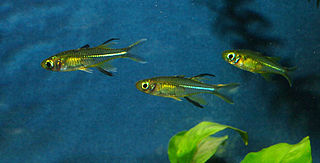Nomorhamphus weberi is a species of viviparous halfbeak endemic to Lake Matano in Sulawesi, Indonesia. This species can reach a length of 7.5 centimetres (3.0 in) SL. The specific name honours the Dutch ichthyologist Max Carl Wilhelm Weber (1852-1937).
The Waigeo rainbowfish is a species of rainbowfish in the subfamily Melanotaeniinae. It is endemic to West Papua in Indonesia. It reaches a maximum length of around 7.5 cm. This species was described as Rhombatractus catherinae in 1910 by Lieven Ferdinand de Beaufort from a type locality which was given as a rivulet flowing into the Rabial River in Waigeo. de Beaufort gave this species the specific name catherinae to honour his wife, Catherine, who had assisted him on the expedition on which the type was collected.

The Lake Tebera rainbowfish is a species of rainbowfish in the subfamily Melanotaeniinae which is endemic to the Lake Tebera basin in Papua New Guinea. The specific name honours the pet-book publisher Herbert R. Axelrod (1927–2017).
Van Heurn's rainbowfish is a species of rainbowfish in the subfamily Melanotaeniinae. It is endemic to West Papua in Indonesia. The specific name honours the Dutch zoologist Willem Cornelis van Heurn (1887-1972).
Paratherina wolterecki is a species of fish in the subfamily Telmatherininae, part of the rainbowfish family Melanotaeniidae. This species is endemic to Lakes Towuti and Mahalona on the Indonesian island of Sulawesi. It reaches up to 15 cm (5.9 in) in total length. Their environment is pelagic and they live in tropical climates. It has the characteristic of having a mouth pointed upward. The specific name honours the hydrologist and biologist Richard Woltereck (1877-1944), who collected specimens of all four species in the genus Paratherina and who sketched them from life.
Mugilogobius sarasinorum, Sarasin's goby, is a species of goby endemic to Lake Poso in Sulawesi, Indonesia. This species can reach a length of 8 centimetres (3.1 in) TL. Sarasin's goby is important to local commercial fisheries and the fishing community.
Telmatherina abendanoni is a species of fish in the subfamily Telmatherininae part of the family Melanotaeniidae, the rainbowfishes. It is endemic to Indonesia where it occurs only in Lake Matano on the island of Sulawesi.
Telmatherina antoniae is a species of fish in the subfamily Telmatherininae part of the family Melanotaeniidae, the rainbowfishes. It is endemic to Indonesia where it occurs only in Lake Matano on Sulawesi.

Telmatherina celebensis, also known as the Celebes rainbow, is a species of fish in the subfamily Telmatherininae part of the family Melanotaeniidae, the rainbowfishes. It is endemic to the island of Sulawesi in Indonesia where it has been found to occur in Lakes Towuti and Mahalona, and may also occur in Lake Wawontoa. This species was described in 1897 by George Albert Boulenger from a type locality of Lake Towuti.

The Celebes rainbowfish is a species of sailfin silverside endemic to Sulawesi in Indonesia. It is the only known member of its genus.
Telmatherina opudi is a species of fish in the subfamily Telmatherininae part of the family Melanotaeniidae, the rainbowfishes. It is endemic to Indonesia. his species was described in 1991 by Maurice Kottelat from a type locality of Lake Matano.
Telmatherina sarasinorum is a species of fish in the subfamily Telmatherininae part of the family Melanotaeniidae, the rainbowfishes. It is endemic to Indonesia, where it occurs only in Lake Matano on the island of Sulawesi. This species was described in 1991 by Maurice Kottelat, the types being collected at Mengonuwai on Lake Matano.
Telmatherina wahjui is a species of fish in the subfamily Telmatherininae, which is part of the family Melanotaeniidae; the rainbowfishes. It is endemic to Indonesia, where it occurs only in Lake Matano on the island of Sulawesi. It can reach a maximum length of around 5 centimetres (2.0 in). This species was described in 1991 by Maurice Kottelat with a type locality of Alaponkepi which is situated at the outlet of Lake Matano.
Tondanichthys kottelati is a species of viviparous halfbeak endemic to Indonesia, where it is only known from Lake Tondano near Mount Tondano in the far north of the island of Sulawesi. It grows to a length of 6.4 centimetres (2.5 in) SL. Despite being a member of the viviparous halfbeak family, this species is believed to be oviparous. This species was described in 1995 by Bruce Baden Collette and its species name honours the Swiss ichthyologist Maurice Kottelat.
Popta's buntingi is an endangered species of fish in the family Adrianichthyidae. It is endemic to Lake Poso in Sulawesi, Indonesia.

Oryzias sarasinorum, the Sarasins minnow or Sarasins buntingi, is a species of ricefish in the Adrianichthyidae. It is endemic to Lake Lindu in Lore Lindu National Park, Sulawesi, Indonesia. This species was described as Haplochilus sarasinorum by C.M.L. Popta in 1905 and she named it in honour of the Swiss naturalists and second cousins Paul Sarasin (1856-1929) and Fritz Sarasin (1859-1942), the latter being the collector of the type. Although the IUCN state that the population of this fish is stabled it is threatened by introduced non native fish, common carp, Mozambique tilapia and walking catfish; and a decline in water quality caused by increased agriculture in the lake's catchment which is causing a decline in water quality, it is therefore assessed as Critically Endangered.

Fritz Sarasin, full name Karl Friedrich Sarasin was a Swiss naturalist.
Pelangia mbutaensis is a species of rainbowfish endemic to West Papua in Indonesia. This species was described by Gerald R. Allen in 1988 from types collected from the Lake Mbuta Basin which lies about 8 kilometers northwest of Etna Bay in West Papua. It is the only known member of its genus, the name Pelangia is derived from the Indonesian word for "rainbow" and the specific name refers to the type locality, the swampy basin of Lake Mbuta.
Adrianichthys roseni is a species of ricefish, a member of the family Adrianichthyidae which is endemic to Lake Poso on Sulawesi. Since the holotype was collected in 1978 there have been no reports of this species and if it still exists then it has a very low population. The IUCN categorise it as Critically Endangered.
Glossolepis leggetti, also known as Leggett's rainbowfish, is a species of rainbowfish in the subfamily Melanotaeniinae. It is only found in the Wapoga River system of northern Irian Jaya, Indonesia.





